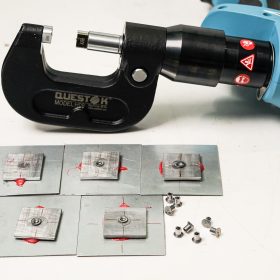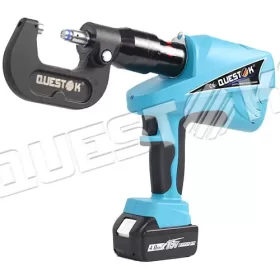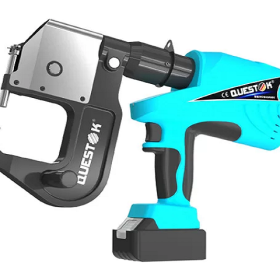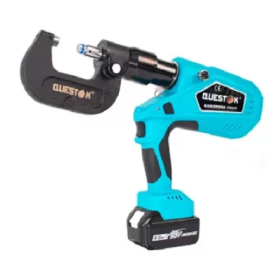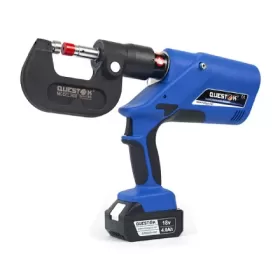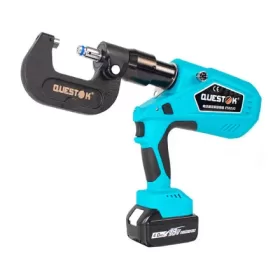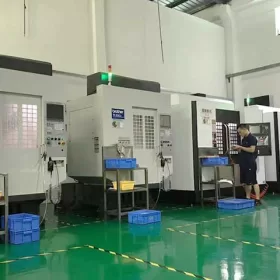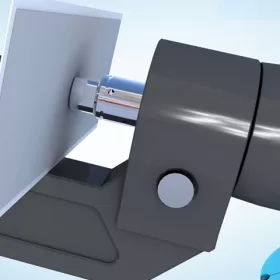Troubleshooting Your Aluminum Rivet Gun- Common Issues and Solutions
Aluminum rivet guns are essential tools for joining aluminum sheets and other materials. However, like any tool, they can occasionally encounter issues that affect their performance. This article aims to provide a comprehensive guide to troubleshooting aluminum rivet guns, addressing common problems and offering practical solutions.
Clogged or Jammed Nozzles
Clogged or jammed nozzles are a common issue that can prevent the rivet gun from functioning properly. The nozzle may become clogged with aluminum shavings or debris, which accumulates over time.
Solutions:
Clean the nozzle: Remove the nozzle and use a wire brush or compressed air to clean out any debris.
Inspect the nozzle for damage: If the nozzle is damaged, it must be replaced.
Apply a lubricant: Apply a small amount of lubricant to the nozzle to reduce friction and prevent clogging.
Faulty Chuck or Piston
The chuck and piston are critical components of the rivet gun that can malfunction if they become worn or damaged. A faulty chuck may not grip the rivet securely, while a damaged piston may affect the riveting process.
Solutions:
Inspect the chuck: Check if the chuck is damaged or worn. If necessary, replace it with a new one.
Clean the piston: Remove the piston and clean it with a solvent or compressed air. Inspect for any damage, such as scratches or cracks.
Replace the piston: If the piston is damaged, replace it with a new one.
Air Leaks or Low Pressure
Air leaks or low pressure can cause the rivet gun to lose power or perform inconsistently. Leaks can occur in the hoses, fittings, or the rivet gun itself.
Solutions:
Check for leaks: Inspect all hoses and fittings for signs of leaks. Use a soapy water solution to identify any air bubbles.
Tighten fittings: If any fittings are loose, tighten them securely with a wrench.
Use a pressure gauge: Connect a pressure gauge to the rivet gun to measure the air pressure. Ensure that the pressure is within the specified range.
Rivet Not Setting Properly
If the rivet is not setting properly, it may not be seated correctly or the rivet gun may be malfunctioning. The rivet should be flush with the material and have a consistent and symmetrical shape.
Solutions:
Check rivet size: Ensure that the rivet size is appropriate for the thickness of the materials being joined.
Clean the rivet hole: Clean the rivet hole to remove any debris or burrs that may interfere with the rivet setting process.
Adjust the rivet gun: If the rivet gun is not setting the rivet properly, adjust the settings or inspect for any mechanical issues.
Overheating
Excessive use or lack of proper lubrication can cause the rivet gun to overheat. Overheating can damage the internal components and reduce the lifespan of the tool.
Solutions:
Allow the rivet gun to cool down: If the rivet gun overheats, stop using it immediately and let it cool down.
Lubricate regularly: Make sure to lubricate the rivet gun as per the manufacturer’s instructions.
Inspect for airflow: Ensure that there is adequate airflow around the rivet gun to prevent overheating.
- Company News
- Industry News
- Tag
- Tags
-
The Advantages of Questok Rivet Guns: Precision, Efficiency, and Durability
In industrial fastening applications, the choice of tools directly impacts productivity, safety, and long-term cost-effectiveness. Questok rivet guns have emerged as a standout solution for professionals across aerospace, automotive, and construction sectors. Combining advanced engineering with user-centric design, these tools deliver unmatched performance. Below are the key advantages that make Questok rivet guns a preferred choice:
-
Rivet Gun FAQ
Rivet Gun FAQ-SPR
-
Fast Assembly and Repair With Cordless Solid Rivet Gun
Questok cordless solid rivet gun stands out as a pivotal innovation, merging portability with power to facilitate efficient and effective fastening in a myriad of applications.
-
Redifine The Role of Self-piercing Riveting Gun Machine
Self-piercing riveting adopts high-speed mechanical fastening skill that joins thin sheet materials, typically steel and aluminum alloys.
-
The Latest Innovations in Clinching Tool Design
Explore the latest innovations in clinching tool design, redefining precision, efficiency, and versatility in material joining.
-
The Application and Maintenance of Self-Piercing Rivet Guns
Delve into the applications of self-piercing rivet guns in the automotive and aerospace industries and reveal the essential maintenance practices that ensure their accuracy and efficiency.
-
Rivetless Riveting Gun for Ventilation Duct Projects
The ventilation duct rivetless gun is a tool for riveting ventilation ducts without rivets.
-
Guide to Using Self-Piercing SPR Riveting Gun
In the automotive industry, self-piercing SPR (Self-Piercing Rivet) riveting guns are commonly used for joining metal components in vehicle bodies, including BMW vehicles.
-
Rivet Gun FAQ
Rivet Gun FAQ-SPR
-
User-Friendly Features- Making Riveting Easy with Electric Blind Rivet Guns
Electric blind rivet guns are essential tools for industrial applications, providing a convenient and efficient way to fasten materials together. These tools have significantly advanced, incorporating user-friendly features that enhance their functionality and ease of operation. This article explores several key user-friendly features of electric blind rivet guns, highlighting how they simplify and streamline the […]
-
Unleashing Potential- Unlocking the Versatility of a Handheld Rivet Gun
In the realm of construction and fabrication, precision and efficiency reign supreme. Among the indispensable tools that empower craftsmen and DIY enthusiasts alike, the handheld rivet gun stands as a beacon of versatility and innovation. This unassuming device harbors a hidden potential that belies its compact form, offering a plethora of applications that unlock unbounded […]
-
Versatile Fastening- Applications of the Handheld Rivet Gun Across Industries
In the realm of fastening, the handheld rivet gun stands as a testament to ingenuity and versatility. Its ability to effortlessly join materials with sheer strength and permanence has revolutionized manufacturing and construction processes, leaving an enduring mark on diverse industries. Aerospace: Where precision and reliability are paramount, the rivet gun shines. In aircraft assembly, […]
-
The Role of Automation in Electric Rivetless Clinching
Electric rivetless clinching (ERC) is a lightweight joining process that eliminates the need for rivets or other fasteners. This can lead to significant cost savings and increased production efficiency. Automation plays a critical role in ERC, enabling high-speed and high-volume production. Automated Feed Systems Automated feed systems are used to accurately position the two workpieces […]
-
Why Choose a Universal Self-Piercing Riveting Gun for Your Projects?
In the realm of construction and fabrication, riveting guns stand as indispensable tools for creating secure and robust connections. Among the various types available, universal self-piercing riveting (SPR) guns have emerged as a game-changer due to their versatility and efficiency. This article will delve into the compelling reasons why choosing a universal self-piercing riveting gun […]
-
Why Choose Stainless Steel Hollow Rivets for Your Projects?
In the world of industrial manufacturing, choosing the right fasteners for your projects is crucial for ensuring longevity and reliability. Among the many options available, stainless steel hollow rivets stand out as a superior choice for a wide range of applications. This article delves into the compelling reasons why stainless steel hollow rivets are the […]
-
Top Trends in Electric Rivetless Clinching Guns
In the realm of fastening technology, electric rivetless clinching guns have emerged as a revolutionary solution for a wide range of industrial applications. These advanced tools offer several преимущества and capabilities, revolutionizing the way businesses approach their fastening needs. Adoption of Brushless Motors Brushless motors have gained significant traction in electric rivetless clinching guns due […]
